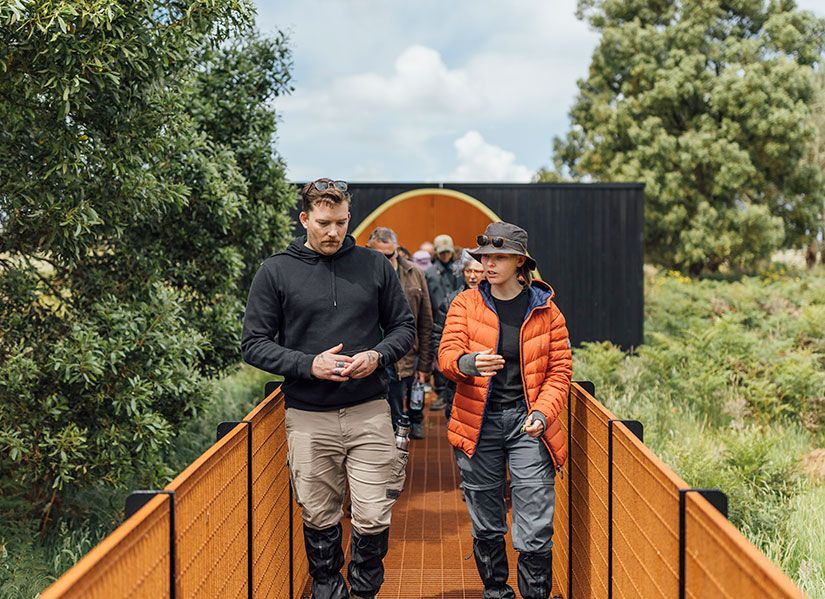
Kim Hellberg, 11 June, 2024
Josh Loyd, a Wajarri yamaji man from Western Australia and a civil engineer, seamlessly merges his professional acumen with Indigenous knowledge to foster Aboriginal co-design and engagement in urban development. As the First Nations Director of Buildings and Places at AECOM, he champions a Country-centered co-design methodology, rooted in a deep understanding of the connection between First Nations peoples and their environment.
With a background spanning prestigious engineering firms, Josh brings a diverse skill set, from construction management to policy development. In his current role, he spearheads projects that prioritise cultural responsiveness and sustainability through the integration of Indigenous perspectives. His passion for Aboriginal co-design and building the Indigenous Estate shows his dedication to creating meaningful and culturally enriched infrastructure.
Here, Josh shares more about his work in this space.
Could you share with us your journey from studying Civil and Environmental Engineering at QUT to becoming the First Nations Director at AECOM?
My first few years of experience were fairly typical and linear; I secured a graduate role with the engineering firm WSP and developed my skills as an engineer while working on major infrastructure projects across Australia. Gradually, I began pursuing opportunities to integrate Indigenous knowledge and practices into my work. After a few years doing this with WSP, I moved between tier 1 engineering consultants and contractors. This shift is what led me into an Indigenous specialist services role, learning and applying a breadth of skills across construction management, industry capability, social impact, policy and strategy development, business development, and perhaps most influentially - change management.
What inspired you to pursue a career in engineering?
I started my professional career in Aboriginal cultural heritage in Pilbara, and was drawn to study engineering at QUT by the quality of support and amenities offered by the Oodgeroo Unit. My curiosity and love for the natural world, combined with witnessing infrastructure's impact on the environment, inspired me. I became fascinated with the interface between culture and infrastructure, and this led me to want to influence outcomes, through design, that reflected my lived experience and worldview.
Can you describe your current role at AECOM and what a typical day looks like for you?
My role and ‘typical day’ is as diverse and varied as the communities and projects that I work with. As an Associate Director at AECOM, I’m responsible for overseeing the integration of Indigenous knowledge and practices into technical services in our Environment, Social and Governance (ESG) and Buildings and Places practices, ensuring projects are culturally responsive and sustainable. This involves a substantial amount of community engagement, research and development, and project oversight. My day almost always involves a blend of business development, internal project coordination, and lots of community and stakeholder engagement.
In your role, you facilitate Aboriginal co-design of the built environment. Can you tell us more about what this entails and some examples of First Nations projects you’ve worked on?
First Nations co-design involves Indigenous communities in planning, design, and delivery to embed cultural values and knowledge. Over my career this has included engineering, architecture, urban design and landscape responses to culturally appropriate social housing, health facilities that blend modern and traditional healing, and transportation and open space projects that enhance the connectivity and resilience of ecological communities. These projects prioritise First Nations community input, creating meaningful, sustainable, and culturally enriched outcomes.
Could you explain your co-design approach and how it incorporates Country, Culture, and Community?
A Country-centred co-design approach starts with understanding the interrelationship between First Nations peoples and the land, sky, and waters. It requires early and consistent engagement with First Nations leadership, that is culturally authentic and involves Elders, Traditional Owners and Knowledge Holders. This approach celebrates unique cultural identities and expression throughout the project lifecycle.
What are some of the key principles and practices that guide your approach to Aboriginal co-design?
It’s essential to co-design the vision and principles for every project. My top three principles are therefore that projects be First Nations-led, community-specific, and have a design impact matching the project's scale. These principles are developed with Traditional Owners, Elders, and Knowledge Holders, and rely on deep listening to fully understand and embed community insights.
How do you engage and collaborate with Aboriginal communities in your projects?
Collaboration and co-design involves building trust through respectful dialogue; this starts with the concept of deep listening, understanding cultural contexts, and requires early and consistent engagement. It often takes time, well beyond what is budgeted for in a standard project’s program, to reach a point where an investment in engagement can pay off in terms of outcomes. Free, prior and informed consent cannot be overstated along with the fact that, at the end of the day, the project will conclude and the building or place and community remain, so providing a legacy that they feel proud of is paramount.
You talk about building the Aboriginal Estate. Can you tell us more about what this is, the importance of building the Aboriginal Estate and how your work contributes to this goal?
The Indigenous estate includes land, water, and sky areas managed by Aboriginal and Torres Strait Islander peoples, encompassing cultural, spiritual, and economic dimensions. It provides opportunities for economic development, supports biodiversity and ecosystem health, and allows for cultural practices. Building the Aboriginal Estate is essential for cultural revitalisation, economic empowerment, social equity, environmental stewardship, addressing historical injustices, and promoting Indigenous rights. My work seeks to foreground First Nations’ voices in the processes of planning, designing, and delivering engineering projects that enhance the Estate with and for First Nations peoples.
What are your hopes for the future of Aboriginal participation in the built environment, and how do you see the industry evolving?
 I’m working towards a society and industry where cultural competency is well understood and there are professional development requirements for all design practitioners that clearly articulate how and why we should improve First Nations participation in the built environment. In this future, it’s standard practice, and Indigenous and non-Indigenous designers are deeply relating Indigenous knowledge and practices into all aspects of their work. I believe that this will ultimately result in far greater outcomes for the Australian community at large by delivering infrastructure that is responsive to local context and microclimates, is more sustainable, resilient, culturally appropriate, and socially impactful.
I’m working towards a society and industry where cultural competency is well understood and there are professional development requirements for all design practitioners that clearly articulate how and why we should improve First Nations participation in the built environment. In this future, it’s standard practice, and Indigenous and non-Indigenous designers are deeply relating Indigenous knowledge and practices into all aspects of their work. I believe that this will ultimately result in far greater outcomes for the Australian community at large by delivering infrastructure that is responsive to local context and microclimates, is more sustainable, resilient, culturally appropriate, and socially impactful.
Josh Loyd
QUT degree - Bachelor of Engineering (Civil and Environmental) (2018)
Have a question for Josh? Connect with him on LinkedIn.
